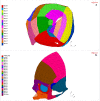Nonlinear dynamic analysis of the pure "buckling" mechanism during blow-out trauma of the human orbit
- PMID: 32943736
- PMCID: PMC7499182
- DOI: 10.1038/s41598-020-72186-1
Nonlinear dynamic analysis of the pure "buckling" mechanism during blow-out trauma of the human orbit
Abstract
Considering the interplay between orbital bones and intraorbital soft tissues, commonly accepted patterns of the blow-out type of trauma within the human orbit require more thorough investigation to assess the minimal health-threatening impact value. Two different three-dimensional finite element method (FEM) models of the human orbital region were developed to simulate the pure "buckling" mechanism of orbital wall fracture in two variants: the model of orbital bone elements and the model of orbital bone, orbit and intraorbital tissue elements. The mechanical properties of the so-defined numerical skull fragment were applied to the model according to the unique laboratory tensile stress tests performed on small and fragile specimens of orbital bones as well as using the data available in the literature. The nonlinear transient analysis of the contact problem between bodies that differ substantially in terms of the Young's modulus was carried out to investigate the interaction of different bodies within an instant injury. Potential damage areas were found within the lower orbital wall as well as the destructive load values for both FEM skull models (7,660 N and 8,520 N). Moreover, numerical simulations were validated by comparing them with computed tomography scans of real injuries.
Conflict of interest statement
The authors declare no competing interests.
Figures







References
-
- Clarke PRR. Fractures of the orbit: (Proceedings of the symposium on orbital fractures, 19–20 April, 1969, Amsterdam) J. Neurol. Sci. 1971;14:121.
-
- Jha K, Rajalakshmi A. Evaluation and management of orbital trauma. J. Clin. Ophthalmol. Res. 2018;6:77–82.
-
- Paluch J. Interdisciplinary surgical management of orbital and maxillo-ethmoidal complex disorders. In: Markowski J, editor. Clinical Management and Evolving Novel Therapeutic Strategies for Patients with Brain Tumors. London: IntechOpen; 2013. pp. 571–595.
-
- Weinzweig J, Taub PJ, Bartlett SP. Fractures of the orbit. In: Weinzweig J, editor. Plastic Surgery Secrets Plus. 2. Maryland Heights: Mosby; 2010. pp. 299–307.
-
- Bregstein J, Roskind CG, Sonnett FM. Emergency medicine. In: Polin RA, Ditmar MF, editors. Pediatric Secrets. 5. Maryland Heights: Mosby; 2011. pp. 154–196.
Publication types
MeSH terms
LinkOut - more resources
Full Text Sources
Medical

